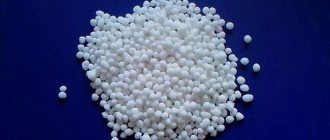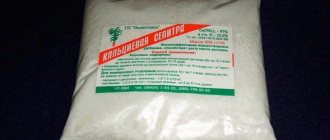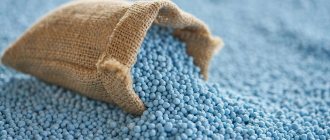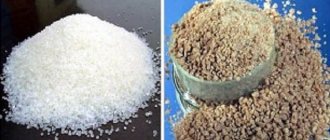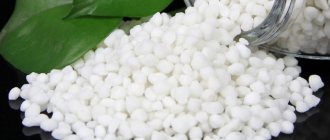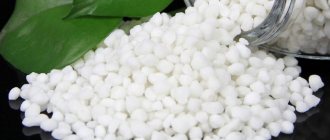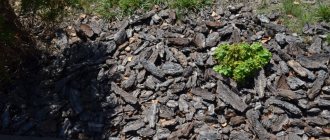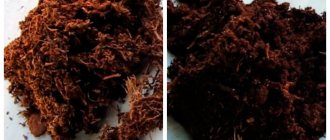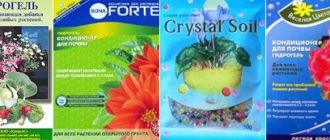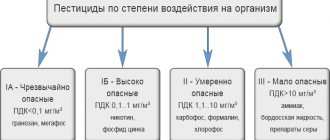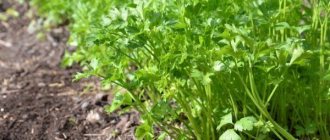Plants in the garden, vegetable garden, and flower garden need various fertilizers, among which calcium nitrate is not the least important. In retail chains it can most often be bought under the name “Fertika”, less often - “Calcium nitrate”.
We will tell you what is remarkable about this fertilizer, what its composition is, method of application and storage rules. We will also talk about the features of application on different crops.
Properties
Calcium nitrate or calcium nitrate is an inorganic substance obtained synthetically. Consists of 15.5% nitrogen and 19% calcium, and is white granules. It is used as a fertilizer for foliar feeding and to combat crop diseases. Calcium nitrate is the only water-soluble source of calcium, so it is often available in liquid form.
Fertilizer helps regulate water in plant tissues, enhances photosynthesis, and reduces soil acidity. This promotes the development of microorganisms that retain nitrogen in the soil. The drug maintains healthy cell walls in plants and helps them absorb other nutrients from the soil.
Foliar spraying prevents color loss in crops and disease of fruits of apple trees, tomatoes and peppers.
Composition and release forms
The formula of calcium nitrate is Ca(NO3)2.
The substance is granules or light white powder. Calcium nitrate is an alkaline fertilizer that is widely used mainly in private households. It is not used on collective farms and agricultural plants due to its strong flowability.
According to the recommendations, the proportion of calcium should be 19%, nitrogen – 15.5. But, as a rule, the nitrogen content is slightly less - 11-13%. This is not a critical error or an indicator of poor quality fertilizer. The fertilizer is packaged in plastic bags weighing 1 and 2 kg. It is more advisable to purchase granules rather than powder, since calcium nitrate is very hygroscopic.
Pros and cons of fertilizer
The drug has its advantages and disadvantages.
Calcium nitrate has more advantages than disadvantages:
- it is a good source of nitrogen;
- it facilitates the absorption of calcium, because contains nitrogen in the form of nitrates;
- calcium is a constituent element of the substance, consumed by plants in large quantities;
- maintains the porous structure of the soil;
- increases productivity and product quality;
- enhances plant resistance to diseases and pests;
- improves product transportability;
- extends the shelf life of fruits;
- contains no additives or fillers;
- does not evaporate, is not washed off and does not cause burns;
- does not increase the alkaline composition of the soil;
- does not increase salt in the soil.
Disadvantages include:
- it is not organic matter;
- Application on open ground is less effective compared to indoor plants.
Advantages and disadvantages
Basically, gardeners note the advantages of fertilizer, almost without highlighting the “cons”.
Among the "pros":
- dissolves well in water;
- used for feeding a large number of crops (vegetables, fruit trees, berries, ornamental plants);
- does not contain chlorine;
- affordable cost of the substance;
- possible use for both root feeding, spraying, and drip irrigation systems;
- If dosages are observed, nitrates do not accumulate in fruits.
The disadvantages are the following:
- Fertilizers in crystalline form cake if storage conditions are violated (high humidity);
- Strict adherence to the instructions for use is required. Overdoses lead to disturbances in plant nutrition, poor absorption of nutritional components from the soil, slowdown in development and suppression of crops.
However, following the instructions and strictly following the recommendations for fertilizing is a mandatory requirement for any applied agrochemicals.
Signs of calcium nitrate deficiency
Calcium nitrate consists of 2 components: nitrogen and calcium. The deficiency of each of them manifests itself in the plant.
Lack of calcium leads to:
- to the acquisition of brown color and death of the tips of young leaves;
- to leaf curling;
- premature falling of flowers;
- to the formation of corky spots on the fruits of garden crops.
Nitrogen deficiency manifests itself:
- in the slow growth of new shoots;
- pale leaves in the middle of the growing season;
- fewer leaves than in previous years;
- early fall of leaves before autumn.
If there is a lack of nitrogen, mineral fertilizer - urea - is also suitable for feeding.
Planting potatoes in holes
Growing potatoes requires fertile soil. There are a large number of microorganisms in the soil: worms, bacteria. During digging, above-ground aerobic organisms are buried and die in the lower layer. And anaerobic microorganisms die when raised from the ground to the surface. In this way, the balance is disrupted, the soil loses its microflora and becomes depleted. In order for the plant to develop better and produce good yields, an agrotechnical method is recommended in which the soil is not dug up, but deeply loosened. After loosening, recesses are made with a special marker - holes into which fertilizers should first be poured, then sprinkled with earth so that the fertilizers do not touch the planting material. Then the prepared potatoes are placed in the hole. Then the holes are filled in and the surface is harrowed with a rake. Potatoes can be planted linearly or in a checkerboard pattern, with a distance of 40 cm. With a checkerboard layout, the plants do not shade each other, and when the tops grow and close together, they provide shade between the rows, which reduces the growth of weeds.
Chess order
This planting method has one drawback, which can be considered a manual method of laying potatoes, without the possibility of using mechanization.
During growth, potatoes take a lot of nutrients from the soil. The soil becomes significantly poorer after growing potatoes on it. When potatoes are repeatedly planted in one place, there is nothing for them to eat, so it is impossible to harvest a good harvest without additional fertilizing.
The need for fertilizing of various crops
The use of calcium nitrate is necessary. Plants require calcium and nitrogen to survive. You can buy calcium nitrate at any garden store; it is a common fertilizer.
Calcium improves the quality of fruits, extends their shelf life, helps plants form seeds, and protects them from diseases and stress.
Nitrogen is an important component in the production of amino acids and chlorophyll. When there is enough of it, the plants have a lush green mass.
Some plants may be more susceptible to calcium deficiency than others. Tomatoes feel this in the heat, their leaves curl inward and their flowers fall off. In apple trees, a cork spot forms on the fruit - fruit rot.
Do not feed the drug to plants that prefer acidic soils, for example: azaleas, ferns, hydrangeas.
The following may die from regular feeding: decorative maple, chamomile, acacia, barberry, honeysuckle, viburnum.
Bulbous flowers, clematis, phlox, such as Drummond's phlox, dahlias, stone fruit trees and grapes love this fertilizer. For pumpkin and nightshade crops, the use of fertilizer is mandatory.
They respond well to feeding: cabbage, legumes, onions and garlic.
What is it for?
Since saltpeter contains an alkaline component - calcium - it is especially suitable for use as a fertilizer for acidic and slightly acidic soils. The presence of calcium gently neutralizes acidity, helping plants adapt to unsuitable soils.
In addition, the presence of calcium in the product promotes enhanced growth of the root system and strengthens the cellular structure of the plant. Calcified soil becomes less acidic after fertilization, resulting in more favorable conditions for plants to grow.
The presence of nitrogen in the preparation helps crops and seedlings to quickly “start” and gives them a supply of important nutrients for the formation of strong shoots and a powerful root system. Since nitrogen causes rapid growth, fertilizers based on it are applied in the spring, at the very beginning of the growing season, or a little later if the plantings are lagging in growth.
Instructions for using fertilizer
Application of calcium nitrate on different types of soils
Calcium nitrate can be used on various types of soil. The best effect is obtained from using the fertilizer on soddy-podzolic, slightly acidic and acidic soils. As a result, the acidity of the soil is neutralized, the soil becomes porous and fertile, and harmful microorganisms and fungi are destroyed.
A weak solution of the drug can be used to treat clay soils and sandy loams.
Deadlines for depositing
It is better to apply calcium nitrate in the spring, when cultivating the site.
The use of fertilizer during autumn digging is not so effective, because... Nitrogen is washed away by groundwater in the spring. Calcium concentration increases, which is harmful to plant roots.
Dosage
The dosage of calcium nitrate when used depends on the purpose of using the fertilizer, the type and age of the plants.
To treat diseased plants, use 4 tablespoons of fertilizer per 5 liters of water. To prevent diseases, 1 tablespoon of the drug is diluted in 5 liters of water. Different crops may have different dosages for feeding.
How to dilute calcium nitrate
The use of calcium nitrate involves diluting the drug in a ratio of 20-25 g. substances per 10 liters of water.
Use:
- for fruit trees, apply at the beginning of the growing season in March-April;
- Water the berries 2 times before flowering begins;
- for vegetables, use the same solution, apply every 10 days.
Calcium nitrate, how to use
In dry form, the drug is used when digging up a site or planting seedlings. Most often, calcium nitrate is used in solutions for root and foliar feeding.
Foliar feeding
The greatest effect can be obtained by spraying plants. For this 2 gr. Dilute the preparation in 1 liter of water and spray on the leaves. Use every 10 days if not using other fertilizers. Liquid consumption per 1 sq. meter 200 ml. drug.
Foliar feeding improves the taste of berries and fruits.
Root feeding with calcium nitrate
Under the root of the plant you need to add 0.5 liters of the drug solution. Dilute 20 grams in 10 liters of water. substances and feed the crops in the evening, on moist soil. Water the root circle of plants. This type of feeding has a long-term effect; foliar feeding gives instant results.
Why do plants need calcium?
Calcium nitrate is a source of sulfur, nitrogen, and calcium. These elements are necessary for normal growth, photosynthesis, and fruit formation.
Calcium is found in cell walls and strengthens stems, leaves and flowers. If there is not enough of this element in the soil, problems with budding arise, plants drop flowers, and fruits are formed of irregular shape. In addition, it will be impossible to store vegetables; putrefactive spots will begin to appear on them.
Calcium nitrate is a fertilizer that qualitatively affects the root system of vegetables, berries and fruits. It stimulates the proper development of roots and the deposition of starch in them, which is important for root crops.
Finding out that a plant needs calcium nitrate is very simple - monitor the development of the crops and their appearance.
These signs will indicate a lack of calcium in the soil.:
- The growth and development of roots is inhibited. They turn black and begin to rot.
- Slow seed germination is observed.
- The seedlings do not take root for a long time. 10% of the landings die.
- The buds of crops fall off and the stems become brittle.
- Brown and yellow spots appear on the leaves.
Calcium fertilizers can be used on acidic soils, which is a big advantage of this nitrate. The bait helps to neutralize heavy metals and acidic components that acidic soils are rich in.
Calcium can accumulate on heavy soils and be washed out on light (sandy) soils.
The use of calcium nitrate in the garden
As mentioned above, the drug is used in dry form and in solution. It is important not to exceed the norm for using the product. To do this, carefully read the instructions for its use.
Feeding seedlings with calcium nitrate
To feed seedlings, dissolve 10 grams in 5 liters of water. saltpeter, 5 gr. urea and 50 gr. ash.
The first feeding is carried out with the appearance of 3 leaves, the second – 10 days after the dive. You should try not to get it on the leaves of the plant.
When to use for flowers
Flowers should be fed with calcium nitrate when they grow poorly or form small buds.
Root fertilizing is carried out every 10 days from the moment of emergence. You can alternate them with foliar treatments. Use 1 teaspoon of the drug per 1 liter of water.
The use of calcium nitrate for tomatoes
Tomatoes love feeding with calcium nitrate, this protects them from pests and black rot. Spray the plants once with a solution of the substance at the beginning of the growing season. Apply root feeding every 10 days. To do this, dissolve 20 g. the drug in a bucket of water and pour or spray on the root circle of the plant.
For cucumbers
Feed the cucumbers every 8 days until the ovaries appear. For root feeding of the plant, dissolve 2 grams. substances in 1 liter of water. Spray with the preparation when 3 leaves appear. We recommend that you look at the article - How to fertilize cucumbers.
DIY fertilizer
Sometimes it is not possible to purchase this drug in a store, then it is very easy to prepare it yourself. To do this, you will need ammonium nitrate and slaked lime, which are always available on the farm. It is necessary to carry out all work outdoors , as an unpleasant odor will be released during the process.
Pour 0.5 liters of water into a pre-prepared 3 liter pan and place it on the fire. Add 0.3 kg of ammonium nitrate to the water, and bring the mixture to a boil. Then gradually, in portions of 150 g, add lime. The whole procedure will take no more than 30 minutes. During the cooking process, a strong smell of ammonia will appear.
As soon as the foreign aroma disappears, the mixture is ready. Pour the clean solution into any clean container, while trying not to touch the dark sediment. The cooled liquid will be a ready-made fertilizer that should be used to feed plants.
Precautionary measures
When working with calcium nitrate, the following precautions must be observed:
- Use personal protective equipment - overalls, goggles, mask or respirator, rubber gloves.
- Do not drink, eat or smoke during treatment.
- After finishing working with saltpeter, wash your hands with soap, wash and take a shower.
In case of contact with skin and mucous membranes, rinse with running water, if swallowed, induce vomiting and seek medical attention.
Storage periods and rules
Calcium nitrate can be stored for a long time, subject to the following rules:
- Stay in a dark, cool room with good ventilation.
- Closed, labeled packaging.
- Store separately from food, drinks, medicines and animal feed.
- Strangers, animals and children should not have access to the premises.
Calcium nitrate is hygroscopic, so the fertilizer must be protected from high humidity. The expiration date is indicated by the manufacturer on the packaging; the drug must be stored in its original container.
